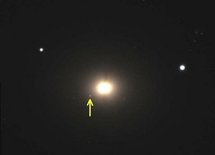
An RGB-composite image of SN 2005cz (arrow) and its host galaxy NGC 4589 taken by Subaru telescope in 2005. (AFP/NAOJ/Subaru Telescope)
Up to now, supernovae -- the most energy-intense and brilliant events visible in the universe -- have been grouped into two classes.
Type Ia are thought to arise when the gravity of a burnt-out rump star called a white dwarf draws off enough material from a similar star nearby -- a process known as accretion -- to become unstable.
At a critical tipping point, the star's ultra-dense core of carbon and oxygen ignites into a shattering thermonuclear blast.
Light curves generated by Type Ia supernovae are so regular and predictable that they are used as benchmarks to measure the speed with which the universe expands.
The other known path to stellar destruction involves the gravitational and catastrophic collapse of a hot, massive star's inner core.
When these stars -- dubbed Type II, or Type Ib or Ic -- become supernovae, they give birth to neutron stars or black holes.
But as to tools for peering into the heavens become more powerful, astronomers have come across supernovae that do not fit neatly into either category.
"We're discovering weird ones that may represent different physical mechanisms compared with the two well-known types, or may just be variations on the standard themes," said Alex Filippenko, a professor at the University of California at Berkeley and co-author of one of the studies.
Both studies, published in the British journal Nature, focus on one such anomalous stellar burst, known as SN 2005E, which became visible in the halo of nearby galaxy NGC 1032 in January 2005.
Like a Type Ia supernova, SN 2005E appeared to arise from white dwarfs. But the calcium and titanium thrust out by the blast some 110 million years ago was evidence of a nuclear reaction involving helium, rather than the Type Ia's signature carbon and oxygen.
At the same time, the lack of any recent star formation nearby, and the relatively paltry mass ejected by the explosion, did not jibe with the Type II core-collapse scenario either.
"The SN 2005E was a different kind of 'bang'," said Filippenko. "It and other calcium-rich supernovae may be a true suborder, not just a one-of-a-kind."
If so, the discovery could explain two puzzling observations.
One is the abundance of calcium. Researchers calculate that about half of the mass thrown out by the explosion was calcium, which means that a couple such supernovae every century would be enough to produce the rich stores of the element found in galaxies such as our own.
The other is the concentration of particles called positrons -- the anti-matter counterpart to electrons -- in the centre of galaxies.
The most widely accepted explanation for the presence of positrons is the decay of putative dark matter.
"Dark matter may or may not exist, but these positrons are perhaps just as easily accounted for by the third type of supernovae," said Avishay Gal-Yam, a researcher at the Weizmann Institute of Science in Rehovot, Israel, and co-author of one of the studies.
------------------------------------------------------------------------
Type Ia are thought to arise when the gravity of a burnt-out rump star called a white dwarf draws off enough material from a similar star nearby -- a process known as accretion -- to become unstable.
At a critical tipping point, the star's ultra-dense core of carbon and oxygen ignites into a shattering thermonuclear blast.
Light curves generated by Type Ia supernovae are so regular and predictable that they are used as benchmarks to measure the speed with which the universe expands.
The other known path to stellar destruction involves the gravitational and catastrophic collapse of a hot, massive star's inner core.
When these stars -- dubbed Type II, or Type Ib or Ic -- become supernovae, they give birth to neutron stars or black holes.
But as to tools for peering into the heavens become more powerful, astronomers have come across supernovae that do not fit neatly into either category.
"We're discovering weird ones that may represent different physical mechanisms compared with the two well-known types, or may just be variations on the standard themes," said Alex Filippenko, a professor at the University of California at Berkeley and co-author of one of the studies.
Both studies, published in the British journal Nature, focus on one such anomalous stellar burst, known as SN 2005E, which became visible in the halo of nearby galaxy NGC 1032 in January 2005.
Like a Type Ia supernova, SN 2005E appeared to arise from white dwarfs. But the calcium and titanium thrust out by the blast some 110 million years ago was evidence of a nuclear reaction involving helium, rather than the Type Ia's signature carbon and oxygen.
At the same time, the lack of any recent star formation nearby, and the relatively paltry mass ejected by the explosion, did not jibe with the Type II core-collapse scenario either.
"The SN 2005E was a different kind of 'bang'," said Filippenko. "It and other calcium-rich supernovae may be a true suborder, not just a one-of-a-kind."
If so, the discovery could explain two puzzling observations.
One is the abundance of calcium. Researchers calculate that about half of the mass thrown out by the explosion was calcium, which means that a couple such supernovae every century would be enough to produce the rich stores of the element found in galaxies such as our own.
The other is the concentration of particles called positrons -- the anti-matter counterpart to electrons -- in the centre of galaxies.
The most widely accepted explanation for the presence of positrons is the decay of putative dark matter.
"Dark matter may or may not exist, but these positrons are perhaps just as easily accounted for by the third type of supernovae," said Avishay Gal-Yam, a researcher at the Weizmann Institute of Science in Rehovot, Israel, and co-author of one of the studies.
------------------------------------------------------------------------









 Home
Home Politics
Politics









